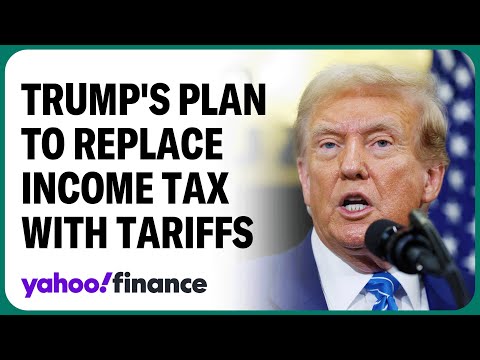Trump's Tariff Plan: Feasibility Of Replacing Income Tax Revenue

Table of Contents
Projected Revenue from Tariffs vs. Income Tax Revenue
A core element of the argument for Trump's tariff plan was the projected revenue it would generate. Comparing this projected revenue to the actual income tax revenue collected reveals a significant discrepancy. While exact figures vary depending on the specific tariffs implemented and the timeframe considered, analyses consistently show that tariff revenue, even at its peak, fell far short of the substantial revenue generated by the income tax system.
The reliability of the revenue projections underpinning Trump's tariff plan is questionable. These projections often relied on economic models that failed to adequately account for several critical factors:
- Historical Data: Historical data clearly shows a vast difference in scale between tariff revenue and income tax revenue. Income tax consistently constitutes a much larger portion of federal revenue.
- Economic Modeling: Various economic models were used to predict tariff revenue, but these models often made assumptions about consumer behavior, retaliatory tariffs, and overall economic stability that proved inaccurate.
- Unforeseen Economic Shocks: Global economic events, such as the COVID-19 pandemic, significantly impacted trade flows and tariff revenue, highlighting the limitations of predictive models. These unforeseen shocks often rendered initial projections unreliable.
Economic Impacts of High Tariffs
The imposition of high tariffs carries substantial economic risks. While proponents argued that tariffs would protect domestic industries and jobs, the reality is far more complex. Significant tariff increases often lead to:
- Increased Prices for Consumers: Tariffs raise the cost of imported goods, directly increasing prices for consumers. This can lead to reduced consumer spending and overall economic slowdown.
- Retaliatory Tariffs: Other countries often retaliate by imposing their own tariffs on U.S. goods, leading to a trade war that harms both economies involved. This tit-for-tat response diminishes the potential benefits of initial tariffs.
- Negative Impact on Specific Industries: Certain industries heavily reliant on imported components or materials are disproportionately affected by tariffs, potentially leading to job losses and reduced competitiveness.
- Potential Job Losses: While some jobs might be saved or created in protected industries, the overall impact on employment can be negative, particularly considering job losses in export-oriented sectors facing retaliatory tariffs.
Distributional Effects of Tariff Revenue
The distributional effects of tariff revenue are crucial to consider. Unlike income tax, which is generally progressive (higher earners pay a larger percentage), tariff revenue is often regressive. This means that lower-income households bear a larger burden relative to their income:
- Impact on Low-Income Households: Low-income households spend a larger proportion of their income on goods affected by tariffs, leading to a larger relative price increase and reduced purchasing power.
- Impact on High-Income Households: High-income households may benefit indirectly from reduced income taxes if tariffs generate revenue, but this benefit is often far smaller than the increased costs they face from higher prices on imported goods and services.
- Distribution of Tariff Revenue Across Different Sectors: The distribution of tariff revenue across sectors is uneven. Some sectors benefit significantly from protection, while others suffer disproportionately.
Alternative Revenue Sources and Policy Considerations
Instead of relying heavily on tariffs, several alternative revenue sources could be explored to replace or supplement income tax revenue:
- Tax Reforms Targeting Corporations or High-Income Earners: Progressive tax reforms could increase tax rates on corporations and high-income earners to generate greater revenue without the negative economic consequences associated with tariffs.
- Value-Added Tax (VAT) or Consumption Taxes: A VAT or broad-based consumption tax could provide a more stable and predictable revenue stream than tariffs, although it could also be regressive if not carefully designed.
- Changes to Estate or Inheritance Taxes: Adjusting estate or inheritance taxes could generate additional revenue, particularly from high-net-worth individuals.
- Increased Government Spending Cuts: Efficient and targeted government spending cuts could free up resources and reduce the need for increased revenue from taxes or tariffs.
Conclusion: The Feasibility of Trump's Tariff Plan as an Income Tax Replacement
In conclusion, the feasibility of replacing income tax revenue with revenue generated from Trump's tariff plan is highly questionable. While tariffs can generate some revenue, their overall economic impact is likely negative, leading to increased prices for consumers, retaliatory tariffs, and potential job losses. The distributional effects are also problematic, with lower-income households disproportionately burdened. Exploring alternative revenue sources, such as progressive tax reforms or efficient spending cuts, presents more sustainable and equitable solutions. Therefore, Trump's tariff plan, despite its initial intentions, is unlikely to be a viable or sustainable long-term solution for replacing income tax revenue. Further research and discussion on "Trump's tariff plan" and its broader economic implications are crucial for informed policymaking.

Featured Posts
-
 Angels Home Opener A Game Marred By Walks And Injuries
May 01, 2025
Angels Home Opener A Game Marred By Walks And Injuries
May 01, 2025 -
 Australias Rugby Struggles A Former Wallabys Perspective
May 01, 2025
Australias Rugby Struggles A Former Wallabys Perspective
May 01, 2025 -
 Quick And Easy Shrimp Ramen Stir Fry
May 01, 2025
Quick And Easy Shrimp Ramen Stir Fry
May 01, 2025 -
 Robinson Nuclear Plants Safety Inspection Success License Renewal Possible Until 2050
May 01, 2025
Robinson Nuclear Plants Safety Inspection Success License Renewal Possible Until 2050
May 01, 2025 -
 Trail Blazers Play In Push A Look At Their Realistic Odds
May 01, 2025
Trail Blazers Play In Push A Look At Their Realistic Odds
May 01, 2025
